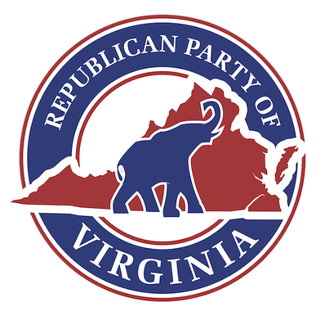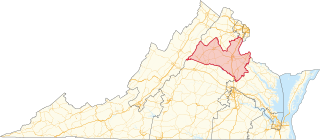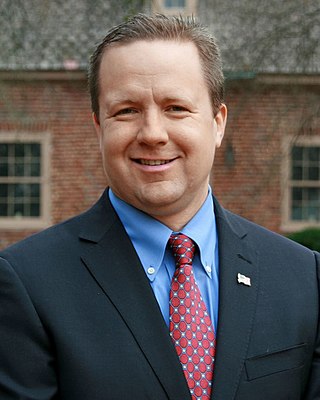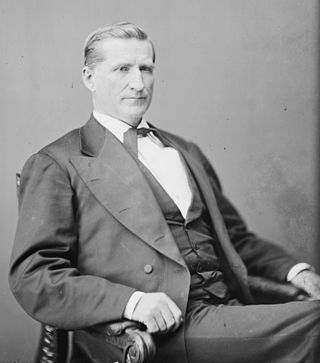
The governor of the Commonwealth of Virginia serves as the head of government of Virginia for a four-year term. The incumbent, Glenn Youngkin, was sworn in on January 15, 2022.

The Virginia General Assembly is the legislative body of the Commonwealth of Virginia, the oldest continuous law-making body in the Western Hemisphere, the first elected legislative assembly in the New World and was established on July 30, 1619.

Winsome Sears is an American politician serving as the 42nd lieutenant governor of Virginia. A member of the Republican Party, Sears served in the Virginia House of Delegates from 2002 to 2004. She also served on the Virginia Board of Education, and she ran unsuccessfully for the U.S. House of Representatives in Virginia's 3rd congressional district in 2004 and for U.S. Senate in 2018. In 2021, Sears was elected lieutenant governor of Virginia.

The attorney general of Virginia is an elected constitutional position that holds an executive office in the government of Virginia. Attorneys general are elected for a four-year term in the year following a presidential election. There are no term limits restricting the number of terms someone can serve as attorney general.

The Republican Party of Virginia (RPV) is the Virginia chapter of the Republican Party. It is based at the Richard D. Obenshain Center in Richmond.

The lieutenant governor of New Jersey is an elected constitutional officer in the executive branch of the state government of New Jersey in the United States. The lieutenant governor is the second highest-ranking official in the state government and is elected concurrently on a ticket with the governor for a four-year term. The position itself does not carry any powers or duties other than to be next in the order of succession, but the state constitution requires that the lieutenant governor also be appointed to serve as the head of a cabinet-level department or administrative agency within the governor's administration, other than the position of Attorney General.

Virginia's seventh congressional district is a United States congressional district in the Commonwealth of Virginia. The district is currently represented by Democrat Abigail Spanberger, first elected in 2018.

The lieutenant governor is a constitutional officer of the Commonwealth of Pennsylvania. The lieutenant governor is elected for a four-year term in the same year as the governor. Each party picks a candidate for lieutenant governor independently of the gubernatorial primary. The winners of the party primaries are then teamed together as a single ticket for the fall general election. The lieutenant governor presides in the Pennsylvania State Senate and is first in the line of succession to the governor; in the event the governor dies, resigns, or otherwise leaves office, the lieutenant governor becomes governor. The Lieutenant Governor casts tie breaking votes in the State Senate.
The government of Virginia combines the executive, legislative and judicial branches of authority in the Commonwealth of Virginia. The current governor of Virginia is Glenn Youngkin. The State Capitol building in Richmond was designed by Thomas Jefferson, and the cornerstone was laid by Governor Patrick Henry in 1785. Virginia currently functions under the 1971 Constitution of Virginia. It is Virginia's seventh constitution. Under the Constitution, the government is composed of three branches: the legislative, the executive and the judicial.
The following table indicates party affiliation in the Commonwealth of Virginia for the individual offices of:

The 2018 United States Senate election in Virginia took place on November 6, 2018, to elect a member of the United States Senate to represent the Commonwealth of Virginia, concurrently with other elections to the U.S. Senate, elections to the United States House of Representatives, and various state and local elections. Incumbent Democratic Senator Tim Kaine, who had been his party's nominee for vice president two years earlier, was re-elected to a second term in office, winning this seat by the largest margin since 1988. This was the first election since 1994 that anyone had been re-elected to this seat.

The Virginia Constitutional Convention of 1901–02 was an assembly of delegates elected by the voters to write the fundamental law of Virginia. The 1902 Constitution's severe restrictions of suffrage among both blacks and whites was proclaimed without submitting it to the people.

The government of Richmond, Virginia, headquartered at Richmond City Hall in Downtown Richmond, is organized under the Charter of Richmond, Virginia and provides for a "strong" mayor-council system. The mayor is elected to a four-year term and is responsible for the administration of city government. The Richmond City Council is a unicameral body consisting of nine members, each elected to represent a geographic district. The city of Richmond is located in the 13th Judicial Circuit of Virginia, and its court system consists of a circuit court and four district courts.

The 2021 Virginia lieutenant gubernatorial election was held on November 2, 2021, to elect the next lieutenant governor of Virginia. Incumbent Democratic Lieutenant Governor Justin Fairfax was eligible to run for a second term, but instead unsuccessfully ran for the Democratic gubernatorial nomination. On November 3, Hala Ayala conceded the race, making Republican Winsome Sears the first black woman to be elected to the lieutenant governorship of Virginia or any statewide office, as well as the first woman elected lieutenant governor in Virginia's history. Sears was also the first Jamaican-American to become a lieutenant governor.

The 2021 Virginia attorney general election was held on November 2, 2021, to elect the next attorney general of Virginia. Democratic Attorney General Mark Herring attempted to win a third term. Herring initially planned to run for governor, but decided to run for re-election. Herring faced Republican nominee Jason Miyares in the general election. Herring conceded defeat at 5:02 PM EST the following day, November 3. Miyares became the first Cuban-American and Hispanic to be elected to statewide office in Virginia. Miyares was later sworn in on January 15, 2022.

United States gubernatorial elections are scheduled to be held on November 4, 2025, in two states, New Jersey and Virginia. These elections form part of the 2025 United States elections. The last gubernatorial elections for New Jersey and Virginia were in 2021. Both incumbents are in-eligible to run for re-election due to term limits. More states may hold elections due to a gubernatorial vacancy or recall of a governor.

The 2025 Virginia gubernatorial election will be held on November 4, 2025. Incumbent Republican Governor Glenn Youngkin will be ineligible to run for re-election, as the Constitution of Virginia prohibits the state's governors from serving consecutive terms.

The 163rd Virginia General Assembly, consisting of members who were elected in both the House and Senate elections in 2023, convened on January 10, 2024. Both elections were the first to be held under maps for both houses of the Virginia General Assembly which were approved by the Virginia Redistricting Commission and the Supreme Court of Virginia in 2021, which were the first in Virginia history to not be drawn and approved by the legislature. Both elections resulted in Democrats winning majorities in both houses for the first time since 2021, with one-seat majorities in both chambers; it was the first time that Democrats won both houses of the legislature against an incumbent Republican governor since 1995.

















































